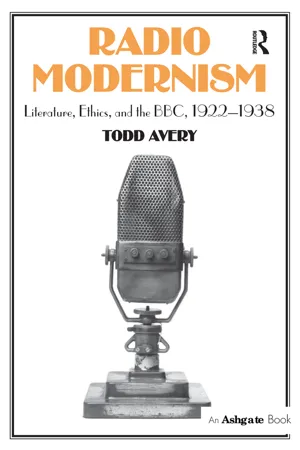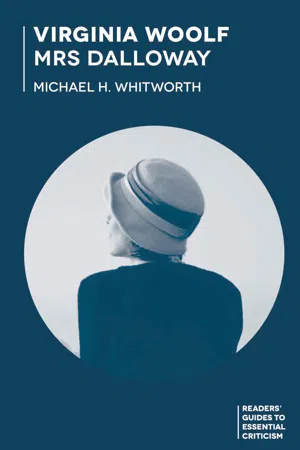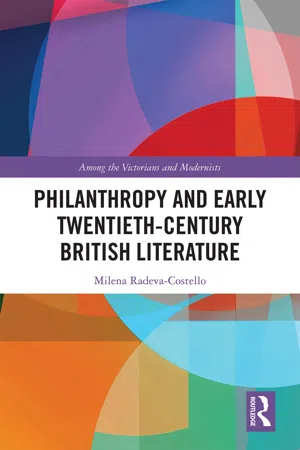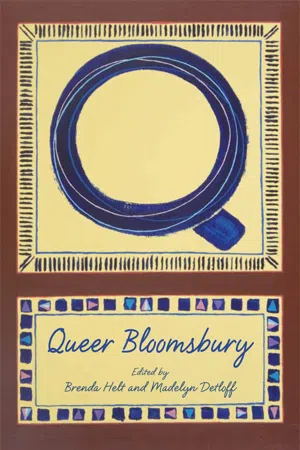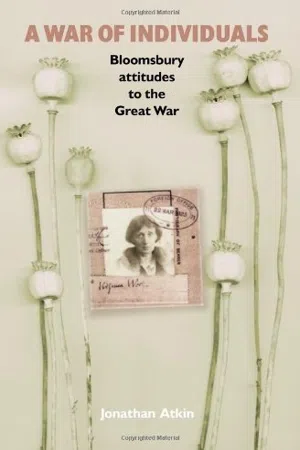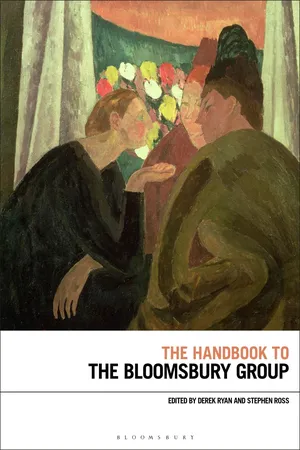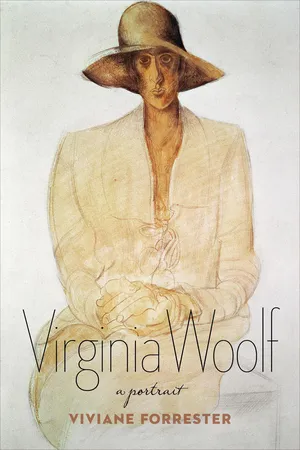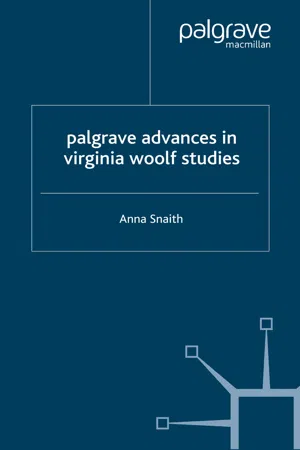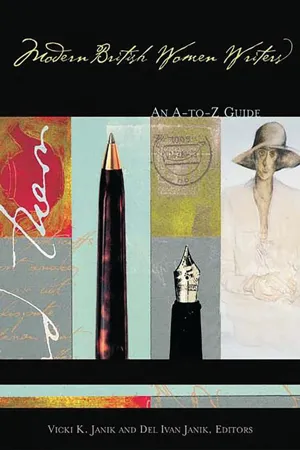Literature
Bloomsbury Group
The Bloomsbury Group was a circle of influential writers, intellectuals, and artists in London during the early 20th century. Known for their unconventional lifestyles and progressive ideas, the group included figures such as Virginia Woolf, E.M. Forster, and John Maynard Keynes. They were known for their impact on literature, art, and social thought, and their legacy continues to influence modern culture.
Written by Perlego with AI-assistance
Related key terms
1 of 5
10 Key excerpts on "Bloomsbury Group"
- eBook - ePub
Radio Modernism
Literature, Ethics, and the BBC, 1922–1938
- Todd Avery(Author)
- 2016(Publication Date)
- Routledge(Publisher)
As Michael Holroyd writes, the Bloomsbury Group "represents more truly than anything else the culmination and ultimate refinement of the aesthetic movement" (Influence 53). Aestheticist principles, inherited from art for art's sake and decadent Victorian writers like Walter Pater and Oscar Wilde, inform a great deal of Bloomsbury's cultural productions and political writings. However, the members of Bloomsbury were no mere modernist reincarnations of George Du Maurier's notorious Jellaby Postlethwaite lunching ocularly on "an aesthetic midday meal" of a freshly cut lily in a glass of water (Small, The Aesthetes, Plate 3), or of the Oscar Wilde pilloried in Gilbert and Sullivan's Patience as a leader of that "greenery-yallery, Grosvenor Gallery" crowd. Nor, as Holroyd suggests—qualifying his aestheticist genealogy of Bloomsbury—were the Bloomsbury intellectuals simply the progeny and propagators of entrenched Victorian cultural traditions and theories (Influence 54). Rather, as widely connected and politically very deeply engaged early twentieth century intellectuals, they were acutely sensitive to the effects of a rapidly changing technocultural landscape upon residual Victorian cultural and ethical ideals, aestheticist and otherwise - Jesse Wolfe(Author)
- 2011(Publication Date)
- Cambridge University Press(Publisher)
Introduction: narrating Bloomsbury Popular and scholarly interests in Bloomsbury have been robust in recent years, with film adaptations of Virginia Woolf’s and E. M. Forster’s novels, homages by Michael Cunningham and Zadie Smith, biographies of several group members, critical examinations of its literary and philosophical importance, and studies of its role in the history of liberalism, feminism, pacifism, gay liberation, and other aspects of culture and politics. 1 This interest suggests that Bloomsbury illuminates many dimensions of modern life. The current turn in modernist studies – toward examining modernity (a social phenomenon) as the context for modernism (aesthetic responses to this phenomenon) – also suggests that Bloomsbury deserves a central role in the story of literary modernism. The following six chapters accord Bloomsbury such a role, and explore how early-twentieth-century modernity, with its demographic and intellec- tual shifts, both inspired and resulted from a reinvention of intimacy that was a primary source of the group’s finest work. From the increased frequency of divorce (which seemed ominous at the time, but seems more modest in retrospect), to the emergence of women in higher educational and professional institutions, to the rise of sexology, psychoanalysis, and subcultures – such as Bloomsbury – organized around loves that had dared not speak their name in the nineteenth century, the period that I examine (roughly 1900 to 1930) saw many signs that an old order was crumbling. The challenges precipitated by these changes were multidimensional. Early-twentieth-century men and women felt themselves to be more coura- geous than their parents and grandparents in the kinds of intimacies they sought – sexually frank ones with spouses and lovers of the same or opposite sex, emotionally honest ones with friends – and believed nineteenth- century forms of association to be staid and unfeeling.- eBook - PDF
- Michael Whitworth(Author)
- 2015(Publication Date)
- Bloomsbury Academic(Publisher)
It was soon followed by Quentin Bell’s Bloomsbury (1968), and for a period in the 1970s and early 1980s, the inclusion of ‘Bloomsbury’ in a book’s title served to increase its appeal to the market. The scholarly work of S. P. Rosen-baum was the most valuable to emerge, as it made available many pre-viously unpublished texts: his edition The Bloomsbury Group: A Collection of Memoirs, Commentary and Criticism (1975) was particularly valuable; The Bloomsbury Group Memoir Club (2014), published posthumously, has yet to make its mark. Richard Shone’s Bloomsbury Portraits: Vanessa Bell, Duncan Grant, and their Circle (1976) revalued the visual culture of Woolf’s sister and her circle. In 1981 Rosenbaum reflected on what a literary history of the Bloomsbury Group might look like, and noted that the term ‘text’ was liberating, while the term ‘work’ tended to embody older limitations on criticism: ‘Much modernist literary theory stil holds that there is a crucial disjunction between works of poetry, fiction, and drama on the one side, and on the other what is lumped together and defined merely negatively as nonfiction’ (334). Such a separation obscured the proper understanding of Bloomsbury’s literary achievement. Rosenbaum noted the polymorphous genre of Woolf’s A Room of One’s Own (1929), and suggested that literary history needed to take its motto from E. M. Forster: ‘Only connect.’ HISTORICIST APPROACHES 125 The creation of such connections was facilitated by the publication of Woolf’s letters and diaries, but those diaries also point to the limitations of ‘Bloomsbury’: while they provide fuller accounts of the men and women known as Bloomsbury, they also make reference to a range of people who could be included in ‘Bloomsbury’ only by the most gener-ous and unscrupulous expansion of the term: for example, the writers Katherine Mansfield and Vita Sackville-West, the composer and suffra-gist Ethel Smyth, the poet and critic T. - Milena Radeva-Costello(Author)
- 2019(Publication Date)
- Routledge(Publisher)
3 Bloomsbury, the Spirit of Cambridge, and the Patronage of the ArtsBloomsbury came about in 1904, when, after the death of their father, the prominent critic and writer Leslie Stephen, Vanessa, Virginia, Thoby, and Adrian Stephen moved to forty-six Gordon square in Bloomsbury, London. In 1905, they started hosting Thursday and Friday evening gatherings at their new lodgings, attended by many of the Stephens’ Cambridge friends. Some of the better-known members of Bloomsbury included the writers Virginia Woolf, Leonard Woolf, Lytton Strachey, and E. M. Forster; the painters Vanessa Bell and Duncan Grant; the art critics Roger Fry and Clive Bell; the journalist Desmond MacCarthy and his wife Molly McCarthy; the economist John Maynard Keynes; and the psychoanalyst Adrian Stephen. The society continued to meet at least until the beginning of World War I in 1914.Bloomsbury has come to mean many things to many people; as Richard Shone said,Received notions of Bloomsbury, friendly ones as well as hostile, invariably wilt under close inspection: personal prejudice makes do for historical accuracy and the word Bloomsbury is tossed about, proteiform on a sea of misapprehension, assuming whatever shape and colour suits the writer’s own agenda. (20)One of the groups, Leonard Woolf, went so far as to write in his biography that Bloomsbury was largely an invention: “‘What came to be called Bloomsbury’ by the outside world never existed in the form given to it by the outside world …. We were and always remained primarily and fundamentally a group of friends” (Beginning Again 22–23). These friends shared a “sense of profound intimacy” (Beginning Again 33), a continuation of their Cambridge friendships, which now extended to the women artists in Bloomsbury. Even though neither Adrian and Thoby Stephen nor their father Leslie Stephen had been part of the Cambridge secret debate society, the Apostles, most of the male members of Bloomsbury, like Leonard Woolf, John Maynard Keynes, Desmond MacCarthy, E.M. Forster, Saxon Syndey-Turner, and Lytton Strachey, had been active members. In this way, as Leonard Woolf wrote, “Bloomsbury grew directly out of Cambridge” (Beginning Again 155). The Cambridge Apostles, and therefore Bloomsbury, had been influenced by Cambridge philosophy in the early twentieth century, such as the publication of G.E. Moore’s Principia Ethica and of Bertrand Russell’s Principles of Mathematics- eBook - PDF
- Brenda S. Helt, Madelyn Detloff(Authors)
- 2016(Publication Date)
- Edinburgh University Press(Publisher)
Finally, of course, there is Virginia Woolf, a novelist of genius each of whose works was a new experiment in the technique of fiction. Strachey might have been thinking of the Bloomsbury Group when he praised the salon of Julie de Lespinasse: If one were privileged to go there often, one found there what one found nowhere else – a sense of freedom and intimacy which was the outcome of real equality, a real understanding, a real friendship such as have existed, before or since, in few societies indeed. Not for distribution or resale. For personal use only. The Bloomsbury Group 35 But surely neither the members of that salon, nor of any other, produced so much work, or so greatly transformed the culture of their country, or represented, along the spectrum of intellectual interests, so wide a range. A word must be said about G. E. Moore, the Cambridge philosopher, whose Principia Ethica has mistakenly been credited with providing the entire ethos of Bloomsbury. J. K. Johnstone’s book, the only one so far devoted to the group, was written, necessarily, with too little information available; sus-pecting ritual, Johnstone sought the dogma to explain it. Quentin Bell’s new book indicates that, in fact, the group, while admiring Moore’s work, used it as justification for its own already held convictions; Keynes’s memoir, carefully read, can be seen to admit that the Principia provided an expost philosophical justification for immoralism, in Gide’s meaning of the word. What is of more immediate interest about Moore is the sort of man he was: brilliant, gentle, generous of heart and virtuous. His influence on English philosophic thought was, as C. D. Broad has said, out of all proportion to his comparatively small literary output. It was by his discussions, his conversa-tions, mainly with students, that his influence was felt. - eBook - ePub
- Jonathan Atkin(Author)
- 2013(Publication Date)
- Manchester University Press(Publisher)
2BloomsburyWhat were the anti-war feelings chiefly expressed outside ‘organised’ protest and not under political or religious banners – those attitudes which form the raison d’être for this study? As the Great War becomes more distant in time, certain actions and individuals become greyer and more obscure whilst others seem to become clearer and imbued with a dash of colour amid the sepia. One thinks particularly of the so-called Bloomsbury Group.1 Any overview of ‘alternative’ attitudes to the war must consider the responses of Bloomsbury to the shadows of doubt and uncertainty thrown across page and canvas by the conflict. Despite their notoriety, the reactions of the Bloomsbury individuals are important both in their own right and as a mirror to the similar reactions of obscurer individuals from differing circumstances and backgrounds.In the origins of Bloomsbury – well known as one of the foremost cultural groups of the late Victorian and Edwardian periods – is to be found the moral and aesthetic core for some of the most significant humanistic reactions to the war. The small circle of Cambridge undergraduates whose mutual appreciation of the thoughts and teachings of the academic and philosopher G.E. Moore led them to form lasting friendships, became the kernel of what would become labelled ‘the Bloomsbury Group’. It was, as one academic described, ‘a nucleus from which civilisation has spread outwards’.2 This rippling effect, though temporarily dammed by the keenly-felt constrictions of the war, would continue to flow outwards through the twentieth century, inspiring, as is well known, much analysis and interpretation along the way.The emotions of Bloomsbury mirrored to a large extent those of its mentors. For one of the ‘fathers’ of Bloomsbury, the older Cambridge academic and humanist Goldsworthy Lowes Dickinson,3 the coming of war was disastrous. For him, as Bloomsbury patroness Lady Ottoline Morrell noted in 1916, the war came, ‘like a battering ram, bruising him and knocking him permanently over … he felt the Nation’s calamities more poignantly and devastatingly than any private calamity of his own’.4 Dickinson had himself referred to the time (in August 1914) when the war ‘burst upon the world’ in his published essay ‘The Basis of a Permanent Peace’. Dickinson wrote that the effect of the war upon those who had not followed foreign affairs, and, by implication, were busy with their own lives, was one of incredulity followed by a feeling that it must never happen again. However, peaceful intentions then became ‘submerged’ beneath hopes of victory and fears of defeat. During the waging of the war, ‘the purpose of it is in danger of being forgotten’, he warned, pointing out that soldiers did not possess normal freedoms of choice; ‘Those at the front have not the opportunity to consider the conditions of such a peace’. Hence, he concluded, it was the business of those at home to do so.5 - eBook - PDF
- Derek Ryan, Stephen Ross(Authors)
- 2018(Publication Date)
- Bloomsbury Academic(Publisher)
CHAPTER FIVE Bloomsbury and Philosophy BENJAMIN D. HAGEN Philosophy clearly mattered to the Bloomsbury Group. ‘So fundamental was philosophy to [its] development’, S. P. Rosenbaum asserts, ‘that a literary history of the group must be to some extent a philosophical history too’ ( Victorian Bloomsbury 161). Some matters are indisputable. For instance, that the Conversazione Society at Cambridge University – an exclusive discussion group also known as the Apostles – served as the initial setting of Bloomsbury’s philosophical education. E. M. Forster, Desmond MacCarthy, Roger Fry, Leonard Woolf, Lytton Strachey, and John Maynard Keynes were all elected members. Between Fry and MacCarthy’s respective elections in 1887 and 1896, Bertrand Russell and G. E. Moore also became Apostles and began their work – which continued well into the twentieth century – of opening (and encouraging) the disciplinary rift between analytic and continental methods of philosophical inquiry. Though the Bloomsbury Apostles did not officially read philosophy at university, many of them nevertheless had direct ties to a major event in its history: the emergence of an ‘analytical empiricism’, as Russell calls it, that incorporated a rigorous mathematics, developed ‘a powerful logical technique’, valued linguistic clarity and symbolic precision, and sought to ‘achieve definite answers’ to ‘certain problems’ – thus demonstrating ‘the quality of science’ ( The History 834). Rosenbaum, Ann Banfield, and others have illuminated this Cambridge–Bloomsbury connection, establishing through their research the (possible) influence of the epistemological and ethical innovations of Russell and Moore on the aesthetic, biographical, political, personal, and economical writings of Bloomsbury itself – including works by those who were not Apostles (e.g. Clive Bell) and those who did not attend Cambridge at all (e.g. Virginia Woolf). - Available until 27 Jan |Learn more
Virginia Woolf
A Portrait
- Viviane Forrester, Jody Gladding(Authors)
- 2015(Publication Date)
- Columbia University Press(Publisher)
A circle no more clearly circumscribed than the list of those who compose it. Intellectual art lovers; avant-garde scholars; writers; painters; critics; one major economist, Maynard Keynes. Above all, friends. No writer there is a match for Virginia Woolf. Only one other work is at all groundbreaking, that of Keynes.They are all gifted, often no more than that, and clever, curious within a range of disciplines. Many will be forgotten; for some, their fame will be limited to England. But the group has a major influence, introducing painting, ballet, music to England, a breath of fresh air from Europe. They swept aside, swept past the Victorian era. Above all, Bloomsbury set an example of incomparable personal freedom, undoubtedly unmatched since.For all of them, their genius lay in their freedom, their independence, their influence over their time and their style of living; their natural suppleness of mind and morals. Their mutual, unfailing attachment and their overwhelming constancy, despite snubs, despite sarcasm and wounds.So many passionate rivalries among them; so many sometime lovers brought to their knees by one another; affairs, painful breakups that never for a moment call into question the tenderness that binds them to those they’ve betrayed, supplanted, left, made suffer, and who constitute part of the circle. It is their affection, their long, indomitable intimacy, their trials, and a rare elegance that bind them to one another, forever.Often they all gathered at Charleston for a peaceful weekend, or in London at one person’s house or another, in restaurants, at parties organized by Karin Stephen, Lydia Keynes, Vanessa, and others; some were to be found at the home of the elegant Ottoline Morrell. They would cause or experience great pain and suffering because of each other, without ever weakening their bonds.They will grow old together. Only death will be able to separate them.Here are Clive and Vanessa, never divorced. Duncan Grant and Clive Bell and Roger Fry remain fast friends. Clive long accompanied by Mary Hutchinson—and Virginia laughing: “No, says Mary; and I dont want to hear any more. If Virginia’s going on like this about her house, as well as—I mean if we’ve got to admire 52 Tavistock Square [Virginia’s address at the time] and the WC [bathroom] and the basement, as well as the dress, the genius, the face, the charm, the shoes, the stockings, the wit, the letters, the character, the temper, the manners, the shoe laces, the finger nails, the way she comes in, and the way she goes out—then, my dear Mr Bell, says Mary, I say your sister in law’s high at the price.”10 - eBook - PDF
- A. Snaith(Author)
- 2007(Publication Date)
- Palgrave Macmillan(Publisher)
In the decades since her death, Woolf studies and modernist studies have grown up together (a claim which is also made about Woolf and feminism), though not always in harmony. Modernism, it may be understood, was first established as the construct of an historical phase of post-war criticism, deployed to account for the wide and diverse range of experimental and avant-garde literature of the first three or four decades of the twentieth century. And we can now trace the ways this modernism positioned and introduced Woolf, first as the handmaiden to the literary men of modernism (Joyce, Lawrence, Conrad, Ford, Eliot, Pound 35 36 palgrave advances in virginia woolf studies and Yeats) (see Kenner 1972), and a proponent of Bloomsbury aesthetics (a particularly influential source of formalism for Anglophone modernist criticism), defined with reference to the philosophy of G. E. Moore, and the theories and achievements of Roger Fry, Clive Bell, Lytton Strachey, Duncan Grant, Desmond MacCarthy, Maynard Keynes and Leonard Woolf. General studies of the Bloomsbury Group include those by J. K. Johnstone (1954), Quentin Bell (1968), S. P. Rosenbaum (1975), Leon Edel (1979), Raymond Williams (1980), and David Dowling (1985). Later, as Woolf assisted in the feminist ‘unmanning’ of modernism (Harrison and Peterson 1997), interest has developed in the influence of women in Woolf’s circles, such as Vanessa Bell, Ray Strachey, Jane Harrison, Ethel Smyth, and Dora Carrington (see Marcus 1987; Gillespie 1988; Carpentier 1998; Dunn 1990; Elliott and Wallace 1994). Once feminism took hold of modernism, Woolf became ‘Woolfenstein’ (see DuPlessis), the mother, for a while, of all modernism and of postmodernism. - eBook - PDF
Modern British Women Writers
An A-to-Z Guide
- Vicki K. Janik, Del Ivan Janik, Vicki K. Janik, Del Ivan Janik(Authors)
- 2002(Publication Date)
- Greenwood(Publisher)
Although her early childhood was strongly influenced by staunchly conservative Victorian codes and mores, it was also marked by personal trag- edy, including the death of her mother and sexual abuse. After this oppressive child- hood, however, Woolf found liberation in a highly unusual and much-criticized lifestyle. With the death of her father, Woolf and her sister, Vanessa, lived together and began hosting weekly meetings that included their brother, Thoby, and his Cambridge friends. This eclectic assortment of philosophers, his- torians, economists, writers, and artists even- tually became known as the Bloomsbury Group. Their uninhibited and often-raucous 385 Virginia Woolf meetings—in which Virginia and Vanessa began as observers but eventually became participants—provided a space in which these young intellectuals could challenge the traditions and expectations of their Victorian predecessors. Within this context Woolf was free to develop her artistic vision, to chal- lenge accepted literary conventions, and to form her own social and political beliefs. In addition to these biographical details, it is important to recognize the connection be- tween Woolf's work and the larger social and political conditions in England during these decades. Scholars have long explored the re- lationship between the political circum- stances of the late nineteenth and early twentieth centuries and the birth of modern- ism. In England growing social crises, includ- ing labor unrest, campaigns for Irish independence, women's suffrage, and the death of King Edward VII in 1910, produced a society "more anarchic, more uncontrolled, more 'modern'" (Stansky 4). Modernism continued to mature against a backdrop of social crises, including the two world wars. From the grieving women and shell-shocked veterans who populate her novels to her in- creasingly pacifist politics, Woolf's life, both personally and artistically, was deeply im- pacted by the wars.
Index pages curate the most relevant extracts from our library of academic textbooks. They’ve been created using an in-house natural language model (NLM), each adding context and meaning to key research topics.
